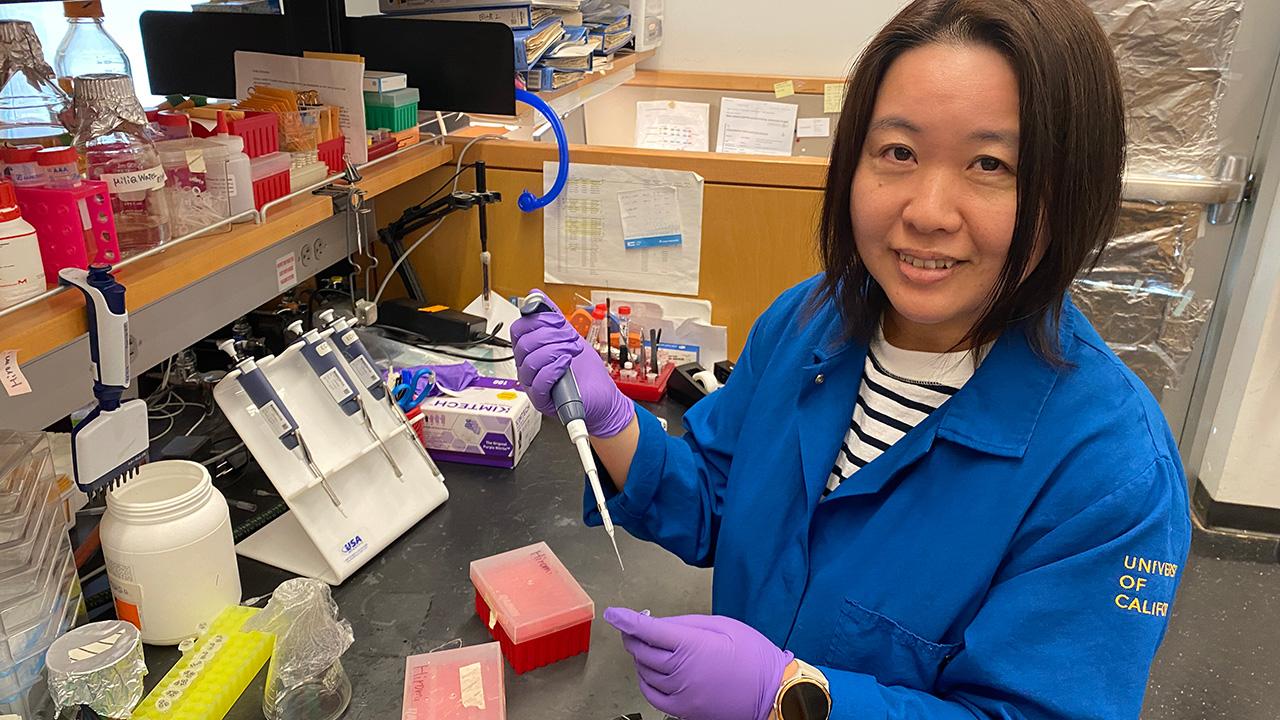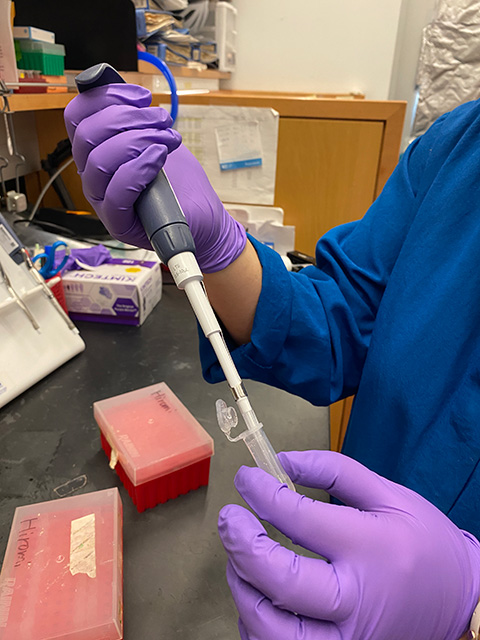
Blumwald lab develops wheat that makes its own fertilizer
Less pollution, lower costs, food security
Scientists in the UC Davis Department of Plant Sciences have developed wheat plants that stimulate the production of their own fertilizer, opening the path toward less pollution in air and water worldwide and lower costs for farmers.
The technology was pioneered by a team led by Eduardo Blumwald, a distinguished professor in the department. The team uses genetic tools to get wheat plants to produce more of one of their own naturally occurring chemicals. When the plant releases the excess chemical into the soil, the chemical helps certain bacteria in the soil convert nitrogen from the air into a form the nearby plants can use to grow. That conversion process is called nitrogen fixation.
A paper describing the team’s research was published online earlier this month in Plant Biotechnology Journal. Hiromi Tajima, Akhilesh Yadav and Javier Hidalgo Castellanos are the research scientists in the Blumwald lab who share first authorship on the paper.
In developing countries, the breakthrough could be a boon for food security, Blumwald said.
“In Africa, people don't use fertilizers because they don’t have money, and farms are small, not larger than six to eight acres,” Blumwald said. “Imagine, you are planting crops that stimulate bacteria in the soil to create the fertilizer that the crops need, naturally. Wow! That’s a big difference!”
The breakthrough in wheat builds on the team’s earlier work in rice. Research also is underway to extend this technology to corn, sorghum and millet. These five grains are among those most commonly grown.
Worldwide, wheat is the No. 2 cereal crop by yield and takes the biggest share of nitrogen fertilizer, using about 18 percent of the total. Globally, more than 800 million tons of fertilizer were produced in 2020 alone, according to statistics from the United Nations Food and Agriculture Organization.
But plants take up only about 30 to 50 percent of the nitrogen in fertilizer. Much of what they don’t use flows into waterways. There, it fertilizes algae, which blooms into thick, floating mats, gobbles up oxygen in the water and suffocates fish and other aquatic life. In addition, some excess nitrogen in the soil converts to a gas form, nitrous oxide, an extremely potent climate-warming gas that also destroys the protective ozone in Earth’s atmosphere.

The work-around: Protect the fixer
Nitrogen-fixing bacteria produce an enzyme called nitrogenase, the “fixer” in nitrogen fixation. Nitrogenase grabs nitrogen gas from the air and converts it into ammonia, a compound that includes nitrogen. Ammonia can dissolve in water, and nearby plants soak it up.
Nitrogenase only can work in environments with very little oxygen. Plants such as beans, peas and soybeans – called legumes – have structures on their roots – called nodules – that provide a cozy, low-oxygen home for the bacteria to live. The bacteria in the nodules fix nitrogen, using some of it for their own needs and giving the rest to the plant. In return, legumes give the bacteria sugars for their use. This beneficial legume/bacteria interaction is called symbiosis.
Unlike legumes, however most other plants can’t establish a symbiotic relationship with nitrogen-fixing bacteria. This is why farmers use fertilizer.
How to solve the problem?
“For many, many years – I’d say, around 50 years – scientists have been trying to develop cereal crops that produce active root nodules, or to colonize cereals with nitrogen-fixing bacteria. They have not had much success,” Blumwald said. “We used a different approach: We said, the location of the nitrogen-fixing bacteria is not important, so long as the fixed nitrogen can reach the plant, and the plant can use it.”
But this approach raises its own problem: If the bacteria live outside the plant, the nitrogenase can’t work. “Plant roots need oxygen to grow, but oxygen kills the bacterial nitrogenase,” Blumwald explained. “So, in order to protect the nitrogenase, we have to generate conditions of very low oxygen in the soil for the nitrogen-fixing bacteria, but still keep enough oxygen in the soil for the plant roots to grow.
“And that's what we did.”

The team solved the problem by inducing the bacteria to form biofilm, something they do naturally. Biofilm is a sticky layer of sugars, proteins and DNA that surrounds clusters of bacteria, creating a kind of commune, Blumwald said. The biofilm allows the bacteria to attach to surfaces such as rocks, to adapt to changing environments and to share resources such as nutrients. Most importantly, the biofilm is covered with a substance that oxygen cannot pass through. This creates a very-low-oxygen environment for the bacteria in the commune, and nitrogenase in the bacteria can work.
Find the inducer
To get nitrogen-fixing bacteria to create biofilms, the Blumwald team had to figure out which chemical compound in the plant could induce that process.
Starting with their research on rice, Blumwald and team first looked at 2,800 chemicals that plants produce naturally for all kinds of processes. The team then narrowed their focus to 20 chemicals that, among other jobs useful to the plant, also could stimulate bacteria to produce biofilms. They figured out how the plant makes those compounds and which genes control that process. “That was a lot of work,” Blumwald recalled.
Then, the team used the gene-editing tool CRISPR to modify wheat plants to produce more of one of those chemicals, a flavone called apigenin. The wheat, now with more apigenin than it needs, releases the excess through its roots into the soil. In experiments they conducted, apigenin from the wheat stimulated bacteria in the soil to create the protective biofilms, allowing nitrogenase to fix nitrogen and the wheat plants to assimilate it.
The wheat also showed a higher yield than control plants when grown in a very low concentration of nitrogen fertilizer.
Farmers could save billions
Farmers in the United States spent nearly $36 billion on fertilizers in 2023, according to U.S. Department of Agriculture estimates. Blumwald calculates that nearly 500 million acres in the U.S. are planted with cereals.
“Imagine, if you could save 10 percent of the amount of fertilizer being used on that land,” he pondered. “I’m calculating conservatively: That should be a savings of more than a billion dollars every year.”
Lab member Dawei Yan contributed to the research.
A patent application has been filed by the University of California and is pending. Bayer Crop Science and the UC Davis Will Lester Foundation have supported this research. In addition, Grantham Foundation is supporting research to extend this technology to sorghum and millet for use in Africa.
Media Resources
- Read the Blumwald team’s paper, “Increased apigenin in DNA-edited hexaploid wheat promoted soil bacterial nitrogen fixation and improved grain yield under limiting nitrogen fertilizer.”
- Read about the earlier work of the Blumwald team to develop rice that can stimulate its own nitrogen fertilizer here.
Media contact:
- Trina Kleist, UC Davis Department of Plant Sciences, tkleist@ucdavis.edu or (530) 601-6846.
